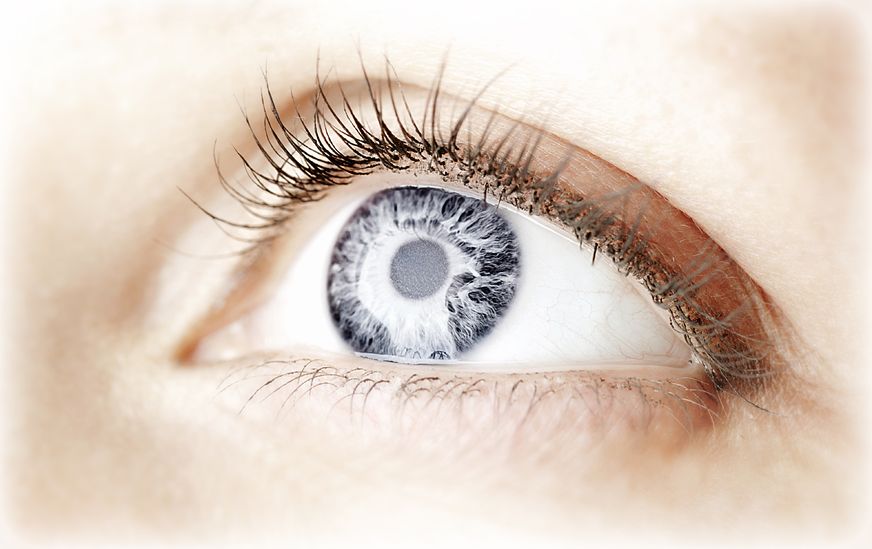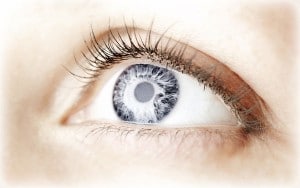Think about how many hours you look at a screen each day. Between your work computer, looking at your smartphone and unwinding with some TV, it really adds up. In fact, research shows that Americans spend at least 50% of each day looking at screens. Unfortunately, this can have some long-term effects on our eyes. This can also lead to something doctors call digital eye strain, which can cause blurred vision, dry eyes and double vision.

To protect your vision and your eye health, follow some of our top tips below.
Maintain a healthy distance. Remember when your parents told you to not sit too close to the TV as a kid? Turns out they might have been on to something. Our eyes aren’t meant to constantly look at things up close. Your eyes actually have to work harder to focus on things up close compared with far away. Try keeping your monitor or screen at arm’s length, about 25 inches away instead.
Take breaks. Some people call this the 20/20/20 rule. For this, take 20-second breaks every 20 minutes of screen time. During your break, try looking at things at least 20 feet away. You could gaze out the window for a bit, look across the room or go for a walk. This will help to give your eyes a much-deserved rest.
Lubricate your eyes. When you’re staring at your computer, it can be common to blink less. This dries out your eyes and can lead to irritation. So, make sure you blink regularly to keep your eyes lubricated and prevent fatigue. While you’re giving your eyes a break from screens, try some lubricating eye drops to help ease dryness. You can also consider using a humidifier to increase the moisture in the air in your home or office.
Give your eyes a rest. Your eyes need a longer break from electronics each day. Try putting away your phone for an hour when you’d normally use it. Turn off the TV before getting ready for bed. If you spend a lot of time during the day on screens, limit screen time on nights and weekends. Consider reading books instead of e-books, for example. The key is to give your eyes rest in between periods of screen time. Getting enough sleep is also extremely important if you’re spending a lot of time in front of screens.
Adjust lighting. The light around you can play a big role in eyestrain too. Bright lighting is actually worse for you when looking at a computer screen. Instead, try to lower the lighting around you to about half the brightness of a normal office. We can’t always control the lighting around us, however. In this case, adjust your screen brightness instead. To do this, just turn down the brightness on your monitor and phone a few clicks. Reducing any screen glare can help, too.
Try glasses. You’ve probably seen blue light glasses by now. This eyewear is specially tinted to help reduce the blue light waves that can damage the eyes. These come in prescription and non-prescription options. In fact, most online retailers and drug stores now carry blue light glasses. For some individuals, this helps cut down on headaches, as well.
Your eye health is important to your overall well-being. Over time, our eyesight can worsen due to the overuse of screens and electronics. Make sure to get regular eye checks ups to determine the health of your eyes and eyesight. If you have any questions or concerns, make sure to talk to your optometrist or eye care specialist. They can help further tailor your habits.
Try incorporating these tips into your day and your eyes will thank you!



 The sun can be extremely hard on your eyes. And the damage doesn’t only occur only on bright spring and summer days. Your vision is also at risk of damage from harmful UV rays during the fall and winter months when it’s cloudy outside. That means that you need to protect yourself — and your eyes — year-round. Whatever your preferred outdoor activity, you need to take a few simple steps to prevent lasting, preventable damage to your vision.
The sun can be extremely hard on your eyes. And the damage doesn’t only occur only on bright spring and summer days. Your vision is also at risk of damage from harmful UV rays during the fall and winter months when it’s cloudy outside. That means that you need to protect yourself — and your eyes — year-round. Whatever your preferred outdoor activity, you need to take a few simple steps to prevent lasting, preventable damage to your vision.
 Are you taking good care of your eyes? Protecting your eyes and keeping them healthy depends a lot on you. Here are four great ways to boost your eye health and protect yourself from eye injury and infection:
Are you taking good care of your eyes? Protecting your eyes and keeping them healthy depends a lot on you. Here are four great ways to boost your eye health and protect yourself from eye injury and infection:
 Most of us start to notice changes in our vision after the age of 40. At first, you may need to have anything you’re trying to read farther away to see the words clearly. Or you may need to remove your glasses to see better up close. Print in the newspaper or on a restaurant menu may seem blurry, especially under dim lighting. Most of the time, these are just typical changes in the eye’s focusing ability, called presbyopia. It’s a condition that appears and progresses as we get older. You may also notice that your eyes are drier and/or you see ‘floaters’ or ‘flashers,” small shapes or flashes of light that appear in your field of vision.
Most of us start to notice changes in our vision after the age of 40. At first, you may need to have anything you’re trying to read farther away to see the words clearly. Or you may need to remove your glasses to see better up close. Print in the newspaper or on a restaurant menu may seem blurry, especially under dim lighting. Most of the time, these are just typical changes in the eye’s focusing ability, called presbyopia. It’s a condition that appears and progresses as we get older. You may also notice that your eyes are drier and/or you see ‘floaters’ or ‘flashers,” small shapes or flashes of light that appear in your field of vision.
 Feeling a bit stressed out? Get your smile on! Numerous studies have shown that smiling releases endorphins, natural painkillers, and serotonin. These three neurotransmitters make us feel happier and less stressed. The effect on our mood and health is similar to exercise and good sleep — it simply makes you feel better. In one study, smiling made people feel happier, even if they were feeling sad or stressed. Another study shows that smiling can help reduce pain and discomfort.
Feeling a bit stressed out? Get your smile on! Numerous studies have shown that smiling releases endorphins, natural painkillers, and serotonin. These three neurotransmitters make us feel happier and less stressed. The effect on our mood and health is similar to exercise and good sleep — it simply makes you feel better. In one study, smiling made people feel happier, even if they were feeling sad or stressed. Another study shows that smiling can help reduce pain and discomfort.
 You know that drinking enough water is important for your overall health and well-being. But did you know that your eyes depend on proper hydration to function properly? Not drinking enough water each day can lead to eye strain, dry eyes and blurred vision.
You know that drinking enough water is important for your overall health and well-being. But did you know that your eyes depend on proper hydration to function properly? Not drinking enough water each day can lead to eye strain, dry eyes and blurred vision.
 Even though LASIK is one of the most popular (and safest!) elective surgical procedures available today, there are still several myths floating around about it. Here are some common myths of LASIK along with the facts that debunk them:
Even though LASIK is one of the most popular (and safest!) elective surgical procedures available today, there are still several myths floating around about it. Here are some common myths of LASIK along with the facts that debunk them:
 Did you know diet can affect your eyesight? It’s true. Although these six foods won’t fix vision issues, they can have a positive impact on your overall and optical health. They may even reduce your chances of getting macular degeneration.
Did you know diet can affect your eyesight? It’s true. Although these six foods won’t fix vision issues, they can have a positive impact on your overall and optical health. They may even reduce your chances of getting macular degeneration.
 You get annual physicals and have your teeth cleaned at your dentist’s office twice a year. How often should you have a vision exam? The answer: You should have your eyes examined every one to two years.
You get annual physicals and have your teeth cleaned at your dentist’s office twice a year. How often should you have a vision exam? The answer: You should have your eyes examined every one to two years.
 Another new school year is here, making it a great time to schedule eye exams for your children. Annual vision checkups are an opportunity to catch and correct eye problems early and prevent eye-related learning issues at school. At Utah Eye Centers, we’re proud to have Dr. Michael Bullard on our team. He is the only full-time Pediatric Ophthalmologist in Weber and Davis Counties and is dedicated to eye issues involving children. He and his team are great with children of all ages and have treated a wide variety of eye problems and conditions, including:
Another new school year is here, making it a great time to schedule eye exams for your children. Annual vision checkups are an opportunity to catch and correct eye problems early and prevent eye-related learning issues at school. At Utah Eye Centers, we’re proud to have Dr. Michael Bullard on our team. He is the only full-time Pediatric Ophthalmologist in Weber and Davis Counties and is dedicated to eye issues involving children. He and his team are great with children of all ages and have treated a wide variety of eye problems and conditions, including: